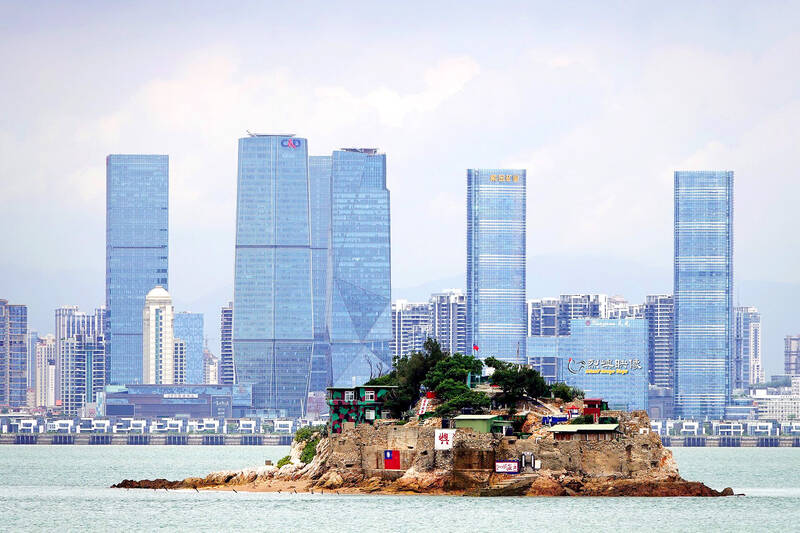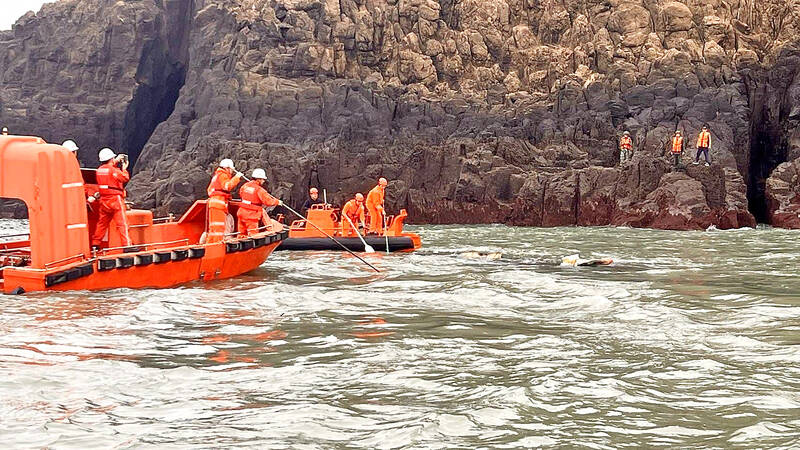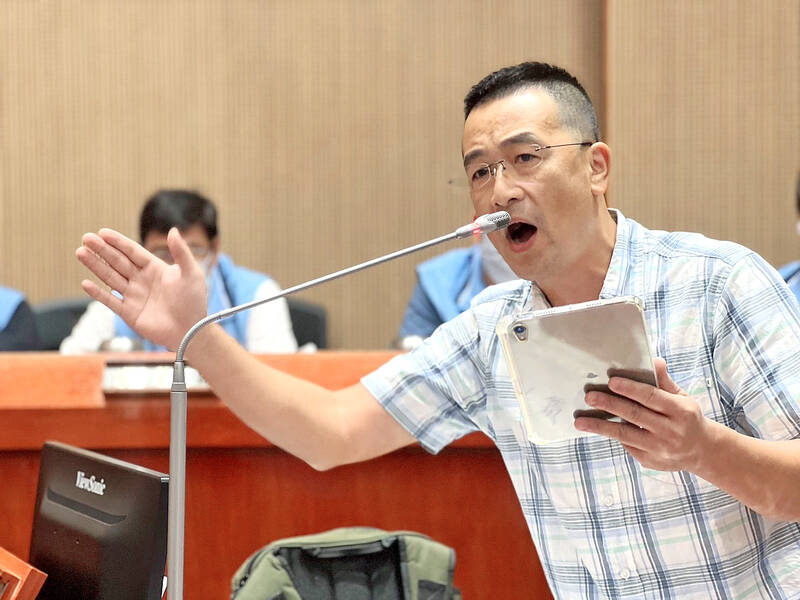Motoring across the calm waters of the South China Sea, Taiwanese captain Lu Wen-shiung recalls the old days, when Chinese and Taiwanese fishers used to meet behind rocky headlands, anchoring their boats out of the authorities’ sight, to share a meal. There was less surveillance then, and the two sides were more friendly, fishing the same waters, occasionally selling to each other on the sly.
“We were like brothers, we had a good relationship, they would even cook for us,” he says. “But … now the control has become more strict, the [Chinese] coast guard will call me if the boats are too close.”
Now a tour boat captain, Lu says if he even gets close to the prohibited water line — a de facto sea border with China — he’ll get a swift warning over the radio from the coast guard.

Photo courtesy of Hung Ching-zhang
Lu and his boat are traveling through the busy waters surrounding Kinmen County, an archipelago controlled by Taiwan that sits a few kilometers from China.
The Chinese Communist party government has become increasingly hostile in its pursuit of annexation, as Taiwan’s government and people only grow more opposed.
Despite the political tensions that exist, Kinmen-Xiamen is one area where official cooperation has actually managed to continue, with joint efforts to crack down on illegal fishing and smuggling, and on search and rescue missions. But a fatal maritime incident last month has threatened to derail it and raised serious questions about the strength of the border.

Photo courtesy of the Coast Guard Administration
A NEW NORMAL
Lu’s boat passes within throwing distance of Kinmen’s outer islands, some of which are open to tourists, while others are restricted for the military. Not far away is the gleaming skyline of China’s Xiamen city, and the surrounding seas heave with fishing boats, civilian ferries and foreign cargo ships. Among them are probably some Chinese vessels known to both sides as “three noes” — no name, no registration, no flag — which often engage in illegal fishing and smuggling. A few hundred meters away, on the other side of a narrow international shipping lane, a Chinese coast guard ship is on patrol.
In February these patrols increased after the fatal capsize of a three-noes boat in Kinmen waters. The boat had fled a Taiwan coast guard vessel which had ordered it to stop for inspection. Two of the four Chinese passengers died, for which China blamed Taiwan. The fury grew when it became clear the two boats had collided — a fact Taiwan’s authorities had initially omitted. Fifteen rounds of closed-door negotiations over responsibility and compensation have so far come to nothing. China accuses Taiwan of evasion and Taiwan accuses China of “absurd” demands like wanting the Taiwanese officers to go to the China for questioning.

Photo: Wu Cheng-ting, Taipei Times
Chinese officials have publicly rejected the existence of the prohibited waters line. Such a statement is consistent with Beijing’s claim over Taiwan, but the line had been tacitly respected since its demarcation in the 1990s. In the days after the collision, China’s coast guard launched extra patrols, one stopping and boarding a Taiwanese tour boat for inspection and scaring the passengers, and some others crossing into Kinmen’s waters.
Experts say both sides are clearly trying to avoid seriously escalating the incident, but the Chinese reaction also fits a pattern of using an incident to establish new norms and encroach on Taiwan’s borders.
The starkest example of this tactic came in August 2022, when the US speaker Nancy Pelosi visited Taiwan. In response, Chinese military incursions into Taiwan’s air defense identification zone increased and crossings of the median line — Taiwan Strait’s de facto border — have become a regular occurrence.
Around Kinmen, “Beijing has been careful to avoid looking excessively provocative even while using the incident to try to undermine Taiwan’s authority,” says Amanda Hsiao, a Taiwan-based senior China analyst at the International Crisis Group.
“The use of law enforcement patrols as a means of signaling displeasure is likely to continue, but Beijing may also choose to dial the frequency and intensity of those patrols up or down in response to events.”
Last week the director-general of Taiwan’s National Security Bureau, Tsai Ming-ye (蔡明彥), told parliament that China was running “joint combat readiness patrols” on average every seven to 10 days in an effort to normalize the activity.
‘SILENT AGREEMENT’ ENDS
On Kinmen, residents are relaxed, and dismiss the recent furor as bad faith parties “internationalizing” a tragic accident. Attitudes towards cross-strait relations and national identity are different to those on Taiwan’s main island.
“The geographical economy and culture mean these two areas are always close,” says independent local councilor Tung Sen-po (董森堡).
Kinmen is home to more than 140,000 people. It is a quiet, semi-rural community, with visible signs of thousands of years of culture and hundreds of being a military staging base or frontline to multiple conflicts. The economy once relied on the thousands of soldiers stationed there during and after the Chinese civil war, but has since pivoted to tourism and production of a local liquor, kaoliang. In 2020 it was Taiwan’s fifth-richest county in terms of median income.
The primary worries among Kinmen people are about the tourism economy, and the ongoing restrictions on bilateral travel and trade privileges between their island and Xiamen, which were suspended during the pandemic and only partially restored.
Still, there are some concerns that tensions after the capsize will deter tourists. A taxi driver and hotelier both thought fewer domestic visitors have come since the capsize incident. A couple from Taiwan’s main island, surnamed Qiu and Li, say they were worried while planning their visit, but felt reassured once they arrived.
Some residents are concerned about maritime enforcement. At a fish market in Jincheng township, vendors say some fishing crew and tour boats are nervous to head offshore since Chinese patrols ramped up.
“They are worried about safety, and we are also afraid of conflict,” says Zhang, a seafood seller.
“We don’t think there is any hostility because [fishing crews] sometimes trade at sea, [but] the problem of smuggling is very serious, and sometimes the marine patrols will take care of it, but there are few of us and a lot of them.”
In the past, China and Taiwan have cooperated on illegal activity in the strait but the future is now complicated.
Raymond Kuo, a political scientist at the Rand Corporation, says the standoff increases the risk of misunderstandings and accidents.
“Not just between Chinese and Taiwanese enforcement agencies, but also between those agencies and civilians in the area,” he says.
“Whose rules and orders should they follow? What if they receive contradictory instructions? This disagreement in enforcement jurisdictions also creates opportunities for illegal activity.”
Chinese negotiators left Kinmen weeks ago without an agreement on compensation. Taiwan’s Ocean Affairs Council minister, Kuan Bi-ling (管碧玲), has apologized for poor evidence-collecting by Taiwan’s coast guard, and expressed regret and condolences over the deaths. But Taiwan’s investigation is ongoing, and further information would not be released until it was completed, she said.
On Wednesday last week, Chen Binhua (陳斌華), spokesperson for China’s Taiwan Affairs Office, accused Taipei of stalling, and threatened further countermeasures.
Less than 24 hours later, at least two Chinese fishers were killed in another capsize, this time a registered fishing vessel near Dongding, Kinmen’s southernmost island. It was inside the prohibited waters, but the cause wasn’t clear. Chinese and Taiwanese authorities conducted the search and rescue, suggesting that at least for now, some cooperation is continuing.
But so are the increased patrols. Over the weekend, four Chinese coastguard vessels entered Kinmen’s waters on consecutive days, causing confusion among Taiwanese officials who had just sent help to the capsize.
Tung says the “silent agreement” on the border is gone now, but hopes the two sides can formalize it during negotiations.
Lu too is hopeful that the two sides can move on, and Kinmen’s unique position between the two can return to friendlier times.
“The incident could have been minimized in the first place, but now it has become an international issue,” he says.

On April 26, The Lancet published a letter from two doctors at Taichung-based China Medical University Hospital (CMUH) warning that “Taiwan’s Health Care System is on the Brink of Collapse.” The authors said that “Years of policy inaction and mismanagement of resources have led to the National Health Insurance system operating under unsustainable conditions.” The pushback was immediate. Errors in the paper were quickly identified and publicized, to discredit the authors (the hospital apologized). CNA reported that CMUH said the letter described Taiwan in 2021 as having 62 nurses per 10,000 people, when the correct number was 78 nurses per 10,000

As we live longer, our risk of cognitive impairment is increasing. How can we delay the onset of symptoms? Do we have to give up every indulgence or can small changes make a difference? We asked neurologists for tips on how to keep our brains healthy for life. TAKE CARE OF YOUR HEALTH “All of the sensible things that apply to bodily health apply to brain health,” says Suzanne O’Sullivan, a consultant in neurology at the National Hospital for Neurology and Neurosurgery in London, and the author of The Age of Diagnosis. “When you’re 20, you can get away with absolute

May 5 to May 11 What started out as friction between Taiwanese students at Taichung First High School and a Japanese head cook escalated dramatically over the first two weeks of May 1927. It began on April 30 when the cook’s wife knew that lotus starch used in that night’s dinner had rat feces in it, but failed to inform staff until the meal was already prepared. The students believed that her silence was intentional, and filed a complaint. The school’s Japanese administrators sided with the cook’s family, dismissing the students as troublemakers and clamping down on their freedoms — with

As Donald Trump’s executive order in March led to the shuttering of Voice of America (VOA) — the global broadcaster whose roots date back to the fight against Nazi propaganda — he quickly attracted support from figures not used to aligning themselves with any US administration. Trump had ordered the US Agency for Global Media, the federal agency that funds VOA and other groups promoting independent journalism overseas, to be “eliminated to the maximum extent consistent with applicable law.” The decision suddenly halted programming in 49 languages to more than 425 million people. In Moscow, Margarita Simonyan, the hardline editor-in-chief of the